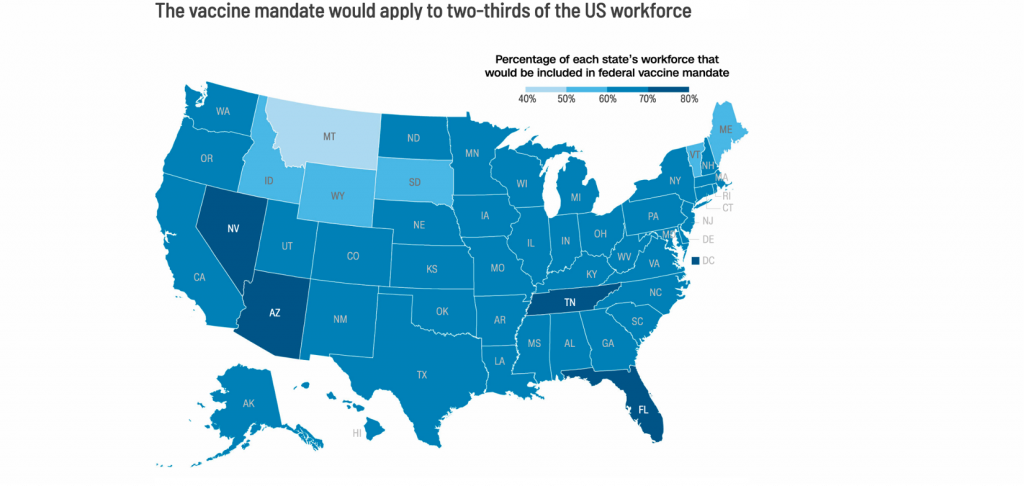President Biden recently outlined a plan that if implemented would require workers in the private sector – companies with 100 or more employees – to get vaccinated against COVID-19 or undergo weekly testing for the virus. The mandate will impact 80 million working Americans, which represents two thirds of the workforce. Most industries – from utilities to information technology, insurance and financial services, transportation, warehousing, manufacturing, construction, education, healthcare, and others – will all be affected by the mandate.

OSHA to Implement Vaccination Measures
The vaccination and testing plan once written and published would utilize a seldom-used and often contested emergency temporary standard (ETS), issued by the U.S. Department of Labor’s Occupational Safety and Health Administration (OSHA). The ETS in addition to the vaccination/testing mandate will also require covered employers to provide employees paid time off to get vaccinated and recover from side effects associated with the COVID-19 vaccine.
OSHA has not announced when the ETS rule would be made public and it is also unclear when it would take effect. OSHA can implement an emergency standard when workers are exposed to a “grave danger” and the standard is needed to protect them. This seldom-used approach enables the agency to reduce the time it typically takes to develop a standard, which averages seven years.
The OSHA rule has already drawn legal challenges on several fronts. The Consumer Brand Association, whose members include high-profile companies, wrote the Biden administration requesting clarification on issues including how workers would be required to demonstrate vaccination compliance and whether they need to be fully vaccinated to work.
States Issue Vaccination/Testing Requirements for Certain Industry Sectors
At the same time, several states and municipalities are requiring certain categories of workers (healthcare, nursing home employees, P-12 teachers and staff, for example) to be vaccinated. Under these types of mandates, workers who decline the vaccine must comply with measures that do not apply to their vaccinated counterparts, such as weekly COVID-19 testing and/or mask wearing.
What Employers Should Do Prior to OSHA ETS Rules?
Stay current with any Local, County, State, and industry-specific requirements. Continue to review and update any COVID procedures as new information develops. Employers should begin contemplating policies allowing employees the choice of testing or proof of vaccination, so that decisions on policy can be made timely once the ETS is published. Additional topics to consider as policies and procedures are being created are potential leaves of absence, discrimination, accommodation, incentives, and privacy concerns, as many of these issues are expected to be addressed in the ETS.
It’s critical for employers to be aware of their state’s Workers’ Compensation statutes with regard to vaccination mandates in order to understand how to craft policies in addition to any government mandates that affect the organization. It is important to consider the impact of the ETS, if implemented, on your Workers’ Compensation program which has received little attention to date but could have both short and long-term ramifications.
Once OSHA clarifies its ruling, Prescient National will be better able to discuss its impact on Workers’ Compensation insurance and measures to help mitigate both Workers’ Compensation and employer liability. We will also continue to keep you updated on any new COVID-19-related workplace developments and directives.




